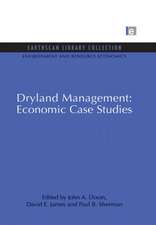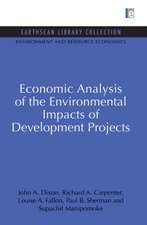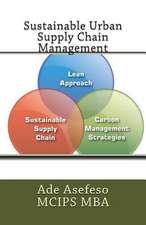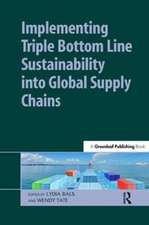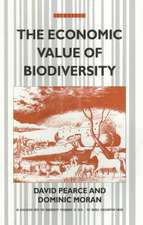Economics of Dryland Management: Environmental and Resource Economics Set
Autor John A. Dixon, David E. James, Paul B. Shermanen Limba Engleză Hardback – oct 2009
Preț: 769.51 lei
Preț vechi: 1030.53 lei
-25% Nou
Puncte Express: 1154
Preț estimativ în valută:
147.29€ • 160.05$ • 123.81£
147.29€ • 160.05$ • 123.81£
Carte tipărită la comandă
Livrare economică 21 aprilie-05 mai
Preluare comenzi: 021 569.72.76
Specificații
ISBN-13: 9781844079544
ISBN-10: 1844079546
Pagini: 324
Dimensiuni: 156 x 234 mm
Greutate: 0.75 kg
Ediția:1
Editura: Taylor & Francis
Colecția Routledge
Seria Environmental and Resource Economics Set
Locul publicării:Oxford, United Kingdom
ISBN-10: 1844079546
Pagini: 324
Dimensiuni: 156 x 234 mm
Greutate: 0.75 kg
Ediția:1
Editura: Taylor & Francis
Colecția Routledge
Seria Environmental and Resource Economics Set
Locul publicării:Oxford, United Kingdom
Cuprins
Foreword Preface 1. The Dry land Problem Dimensions of the problem History and Background of Dryland Usage; Current Conditions in the Drylands; The Future of the DrylandsReferences 2. Dry land Characteristics and the Degradation Process Physical and biological characteristics Climate; Surface Water and Groundwater Resources; Topography and Soils; Vegetation; Animal PopulationsDegradation and land use Degradation Processes; Livestock Production; Rainfed Crop production; Irrigated Agriculture; Forestry andAgroforestry; Other Land UsesSocial and institutional factors Human Factors; Institutional and Political FactorsReferences 3. The Role of Public Policy in Dryland Development and Management Policies Towards the Drylands Diversity of Dryland Problems; The Case for Public Assistance; General Policy Issues in Development Planning; Formulation of Policies, Programmes and Projects; Economics and the Policy ProcessDesigning appropriate policies Economic Issues in Designing Remedial Action; Determining the Appropriate Level of Protection; Desirable Characteristics of Policies, Programmes and ProjectsThe Economics of Dry land ManagementSocial, Cultural and Institutional Factors Human Factors; Institutional FactorsReferences 4. General Economic Principles and Techniques of Analysis Concepts of Economic Welfare Measurement of Benefits and Costs Price Distortions; Economic Externalities; Use Rights and Resource Management Systems; The Effect of Time; Breakdown of Resource Management Systems; Renewable and Non-Renewable Resources; Irreversible Damage to Resources; Risk and UncertaintyDesign of an Economic Analysis Techniques of Economic Analysis References 5. Managing Drylands as Renewable Economic Resources Renewable Production Systems in Dryland Areas Sustainable Production from Dryland Ecosystems; Products of Dryland Areas; Economic Management ObjectivesDegradation: Causes and Corrective Actions Perspective of the Land User; Externalities and Open-Access Common Property Resource Effects; Corrective Policies and StrategiesDryland Agriculture and Forestry Rainfed Crop Management; Dryland Forestry; Appropriate Farm Technology; Soil and Water ConservationGrazing systems key Variables in Grazing Management; Handling Stochastic Conditions; Computer Simulation Modelling of Dryland Grazing SystemsReferences 6. Economic Appraisal of Investments in Dryland Progammes and Projects Financial Analysis Social Benefit�Cost Analysis Project Costs; Physical Boundaries of Analysis; Shadow Prices; Dealing with Inflation; Secondary Impacts;Calculation of Net Social Benefits; Income DistiibutionDecision Criteria Choosing a Decision CriterionCost-Effectiveness Analysis References 7. Valuation of On-Site and Off-Site Effects Valuation of Productivity Changes On-Site Productivity Changes; Off-Site Productivity changes; Effects of Production Changes on Prices, Factor Markets and Consumer's and Producer's SurplusValuation of Other Effects Damage to Property and Materials; Human Life and Health; Population Dislocation; Dealing with Intangibles and Non-QuantifiablesCost Analysis Techniques Preventive Expenditures; Replacement Cost; Opportunity-Cost Approach; Travel-Cost ApproachReferences 8. Risk and Uncertainty in Dryland Development and Management Handling Risk and Uncertainty Sources of Risk and Uncertainty in Dryland Decision-Making; Definitions of Risk and UncertaintyRisk Analysis Applications of Risk Analysis; A Framework for Risk Analysis; Interpretation of Results of Risk AnalysisDecision-Making Under Conditions of Uncertainty Decisions Based on Available Information; Sensitivity Analysis; Decision Analysis Techniques; Uncertainty Associated with Irreversible Damage to ResourcesDefensive Strategies to Cope with Risk and Uncertainty Overcoming the Effects of Risk; Investment in Information;Use of Expert Systems; Adaptive Environmental Assessment and Management; Critical Zones and Safe Minimum StandardsReferences The Economics of Dry land Management9. Models for Dry land Development Planning General Policy Issues in Dryland Development Planning Linear Programming Models General Properties and Applications of Linear Programming Models; Setting up a Linear Programming Model; Finding the Optimum Solution; Introducing an Environmental Externality; Limitations of the Linear Programming ApproachSectoral Planning Models General Properties of Input�Output Models; Solving an Input�Output System; Simulating the Effects of New Production; Incorporating Consumption Expenditure; Data Sources and Construction of Input�Output Models; Application of Multipliers to Dryland Development PlanningNatural-Resource Accounts Approaches to NRAGlobal Models References 10. Implementation of Policies, Programmes and Projects Presenting Results to Decision-Makers Characteristics of a Useful Economic Analysis; Important Elements of an Economic AnalysisCreation of Implementation Incentives Direct Government Expenditure; Influencing Private Behaviour; Characteristics of Efficient IncentivesSelecting the Appropriate Incentives Constraints on the Use of Economic Incentives; A Checklist of Incentive CharacteristicsSocial and Cultural Constraints to Implementation Policies on Land Tenure and Use Rights Systems and Incentives; Accommodation and ChangeManagement of Programmes and Projects Technical Management; Financial Management; Social Management; Administrative ManagementReferences 11. Case Study: Benefit�Cost Analysis of Soil Conservation in Maphutseng, Lesotho by Jan Boj� Background The FISC Project and the Maphutseng AreaThe Economic Analysis Choice of Evaluation Criteria; Quantification of Costs; Quantification of Benefits; Valuation of Costs and Benefits in Economic Prices; Discounting; Time Horizon; Results; Distributional Effects; Uncertainty and Sensitivity Analysis; Summary of Sensitivity Analysis; Policy Implications of the Economic AnalysisThe Financial Analysis The Farmer's Viewpoint; The Long-Run Perspective; Policy Implications of the Financial AnalysisAcknowledgements List of Persons Contacted in LesothoAnnex: Cost Calculations References Index
Notă biografică
John A. Dixon, David E. James, Paul B. Sherman











